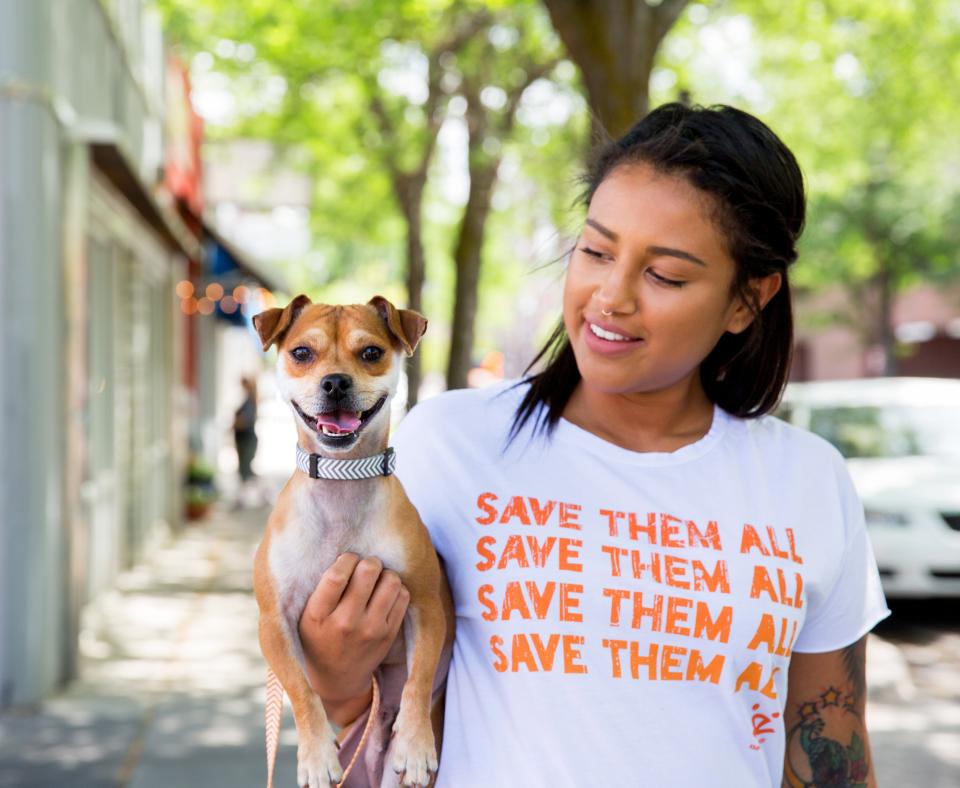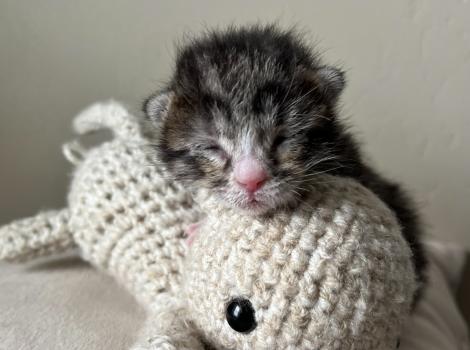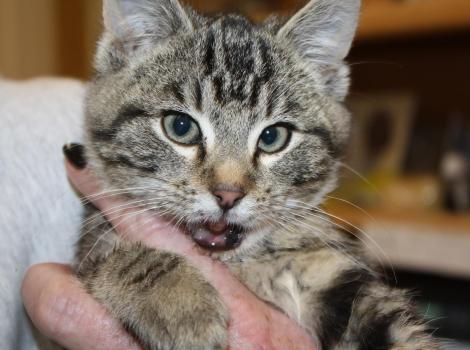Swift teamwork saves kittens with a deadly virus

There is not much in this world more adorable than a pile of fuzzy little kittens, tails all a-waggle as they start to explore their space. And there is not much more concerning than watching those kittens suddenly stop thriving. That was the nightmare staff at Cedar City Animal Shelter found themselves in when several kittens became sick and rapidly started going downhill. The illness spread quickly among litters, and without veterinary staff or the space and resources to quarantine the fragile felines, kittens were dying.
It is, unfortunately, not uncommon for very small kittens to fail to thrive — for any number of reasons. They could have just been born a little smaller and not been able to compete with siblings to nurse. There could be some hidden genetic factor at play. Their mother may not be producing enough milk.
So when the first kitten passed away, it seemed like that was the case: a kitten, sadly, failing to thrive. But when that kitten’s sibling, and then a completely unrelated kitten, started fading, Cedar City Animal Shelter Manager Brittany McCabe knew something else was going on.
“They were perfectly healthy, and then they weren’t,” Brittany recalls, a slight shake in her voice at the memory. With more kittens falling ill, no veterinarian on staff, and no way to test or quarantine the kittens, Brittany says she didn’t know what to do.
The shelter staff weren’t about to give up on those kittens, but they needed help. Best Friends’ goal is for all shelters to reach no-kill, and that means working together with other animal welfare organizations to save pets’ lives, giving each one what they need to move out of the shelter and into a healthy, happy new life.
Best Friends staff had already been working with Cedar City Animal Shelter, which is about 90 minutes away from Best Friends Animal Sanctuary, to help them reach no-kill. So Brittany quickly reached out to someone she hoped could help: Amy Kohlbecker, Best Friends’ Cat World director.
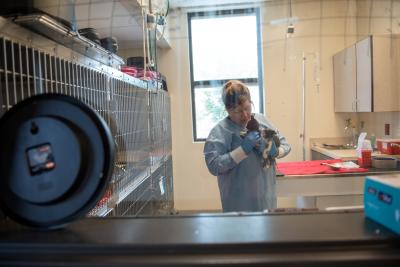
Kittens in crisis
Immediately, Amy was in contact with Sanctuary veterinary staff, discussing the kittens’ symptoms and what options they had. All agreed it sounded like panleukopenia, a highly contagious illness caused by the feline parvovirus. If they didn’t act soon, it would spread and all too easily claim the lives of more tiny kittens.
[Fast action saves two kittens on the brink]
A local volunteer couple who frequented Cedar City Animal Shelter dropped everything to drive the remaining sick kittens and mothers to the Sanctuary, where veterinary staff were standing by. It was 7 p.m., and treatment started the second they were through the doors. One kitten was already too far gone by the time they arrived, and he passed away. The team worked quickly to save the others.
Testing confirmed everyone’s suspicions: They were dealing with panleuk. “Our immediate thought after getting all the kittens into stable condition that night was that the shelter was going to need a lot of support to manage through this situation,” Amy says. “Brittany and her staff were very concerned, and we were in constant communication with them, answering their questions and developing a plan forward.” There was still the matter of the cats and kittens back in Cedar City.
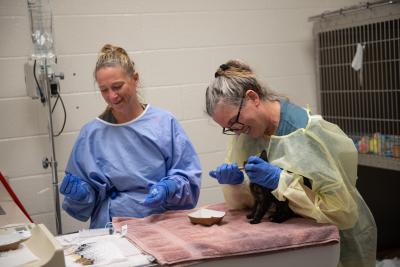
Coming together to keep cats healthy
Another Brittany — Brittany Nataro, Cat World manager — reached out to Cedar City’s Brittany McCabe soon after the first kittens had arrived at the Sanctuary. “She texted me saying ‘I’m coming down. I’m bringing help. We’re going to get this,’” says McCabe. With the first group of kittens in good hands at the Sanctuary, and help on the way, she and the rest of the shelter staff were finally able to breathe again. “It was the first time I’ve dealt with panleuk,” she says. “We’ve had other things that come through — failure to thrive, calicivirus, upper respiratory infections. Those kinds of things. But this was scary. We were all stressed out.”
The very next morning, a team of three Sanctuary staff members, Nataro included, arrived at Cedar City Animal Shelter with panleukopenia tests, cleaning supplies, and determination by the bucketful. They closed the shelter for the whole day to deal with the situation.
[A tiny but mighty kitten fights panleukopenia]
First, they tested the remaining cats — there were around 70 in the shelter at the time — for the illness. There were more sick cats, and they were all soon on their way to join the first group of kittens at the Sanctuary. In total, 25 cats and kittens made the trip. And with quick veterinary care, no more were lost.
Then, together, the teams thoroughly sanitized the room the kittens had been in and put together new protocols for quarantining the area. There were still two newly arrived cats in that room, who they wanted to make sure remained healthy, and they needed to ensure there was no cross-contamination to other rooms of healthy cats.
Anyone entering the room where the sick kittens had been needed to fully gear up in protective gowns. And after they had been in the room to clean and care for the remaining two cats, they had to go straight home.
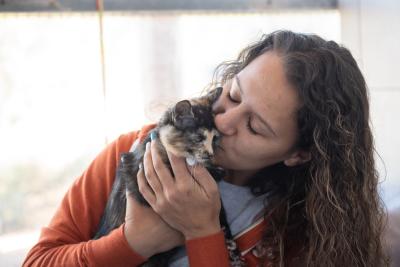
Moving forward
“For two weeks, we were on eggshells,” McCabe says. “We didn’t adopt out any (cats) for two weeks, because we didn’t know — we’d all been in there since the first couple of kittens got sick, and we’d been in other rooms. Anybody and everybody could have been affected.”
But, she says, the situation felt under control after that first busy day. The two cats still in the original room stayed healthy, and no cats in the other rooms became sick. “At the two-week mark, we’d done it,” McCabe says, full of pride and relief. She then happily announced that Casper, one of the two who had remained in the original room where the virus broke out, had since been adopted and gone home quite healthy and happy, while the other cat, Tori, remains in good spirits waiting to be matched with a family of her own.
Meanwhile, the mother cats and kittens who had come to the Sanctuary all responded to rigorous treatment. Though many became very ill, they did turn that corner at last. They regained their strength, perked up, put on weight, and finally started to tumble and play like kittens their age should.
Now they, too, will soon be ready to be matched with loving families. The crisis is past, and everyone can look forward to good things to come — together.
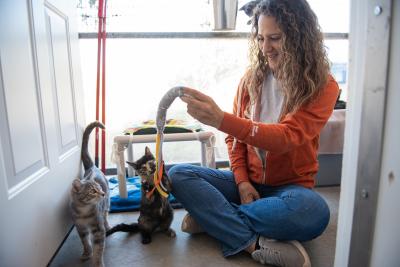
Let's make every shelter and every community no-kill by 2025
Our goal at Best Friends is to support all animal shelters in the U.S. in reaching no-kill by 2025. No-kill means saving every dog and cat in a shelter who can be saved, accounting for community safety and good quality of life for pets.
Shelter staff can’t do it alone. Saving animals in shelters is everyone’s responsibility, and it takes support and participation from the community. No-kill is possible when we work together thoughtfully, honestly, and collaboratively.



